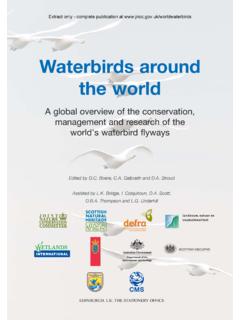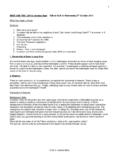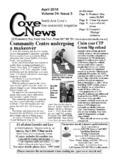Transcription of Habitat - The Wildlife Rescue League
1 This information is reprinted from Rescue Report, the newsletter of the Wildlife Rescue League . WRL is dedicated to the preservation of native Wildlife through rehabilitation and education. If you have a concern about Wildlife in your back yard, contact the Wildlife hotline at (703) 440-0800. The Opossum: Our Marvelous Marsupial, The Social Loner By Erika Yery, Licensed Wildlife Rehabilitator Some time ago, when I first moved into my house and started to remove a huge brush pile in my backyard, I had the fright of my life! There was this scraggly, rat-like animal, with lips drawn back in what it looked like a grin, revealing what appeared to be a huge number of needle-sharp teeth.
2 Beady black eyes stared at me, its mouth drooled, and it was hissing at me it looked like a mini dinosaur. I had encountered my first opossum! Natural History The opossum, Didelphis marsupials, is the only marsupial found in the United States (the young are born prematurely and brought to term in the mother's marsupium, or pouch, in which she nurtures them until they are weaned.) The opossum has several relatives throughout Central and South America, but Australia has the largest number and the greatest variety of these ancient mammals, such as the koala, wallaby, wombat, kangaroo, and sugar glider.
3 Characteristics The North American opossum is also unique in that it is the only mammal in the United States with a prehensile tail, which can be used for grasping like a hand. Young opossums sometimes hang by their tails, but when they grow up, they become too heavy for hanging. The opossum is the only mammal that has four fingers and an opposable thumb on each of its hind feet that works like a human thumb. All nails are non-retractable, except for the thumb. This makes it possible for the opossum to pick up things or hang onto thin branches much better that most other mammals. The opossum is a cat-sized mammal that resembles a silver rat, with its naked ears, long scaly tail, and silver-tipped fur.
4 The face of the opossum is almost pure white, with four rows of whiskers, a pink nose, and eyes like black shoe buttons. The average adult is 24 to 26 inches long, including the tail, and usually weighs between 6 to 12 pounds. The opossum is a passive animal, but looks ferocious when it displays all 50 teeth, drools, and hisses. Due to questions about its intellectual capacity, Vernon Bailey, former chief naturalist for the Biological Survey, was interested in the opossum's brain case. The larger the brain case in relation to the total body size, the more intelligence a creature is. He found that the opossum's brain case held 25 dried beans, while the raccoon's brain case held 150 dried beans, and the house cat's brain case held 125 beans.
5 The opossum may have the smallest brain-to-body ratio among mammals, but it does have an acute sense of hearing and smell. The opossum's life span ranges from 2 to 3 years; mortality is particularly high during the first year of life. Opossums are nocturnal animals, but they are often seen during the day when their natural Habitat has been destroyed, when they are searching for food, or when young and inexperienced youngsters not yet street-wise are looking for food. Habitat Ideal opossum Habitat is woodland, farmland, and suburban neighborhoods with water nearby. But the opossum is very adaptable and will thrive in nearly any Habitat , from wilderness to inner city.
6 It is a common visitor to backyards that provide the basic necessities, such as a source of water, food, and appropriate den sites. The opossum is not particular, and will live almost anywhere. Opossums are often transient, using whatever den is most convenient within their somewhat loose home range, rather than returning to a particular den each day. Females with young tend to be the exception, using the same den sites for weeks at a time. Opossums often use the abandoned burrows of other animals rather than digging their own. Other potential den sites include woodpiles, rocky crevices, culverts, barns, drainpipes, thickets, and in urban neighborhoods under porches, buildings, and storage sheds.
7 Diet The opossum is omnivorous, feeding upon almost anything that it can find or catch: rats, mice, moles, slugs, snails, shrews, worms, beetles, ants, grass-hoppers, crickets, frogs, garbage, fruit (especially persimmons), corns, berries, and even road kill. That habit gets about million opossums killed a year. An opossum seeing an object on a road during the night may believe it to be road kill, and may either freeze in the headlight of a car, or try to run away. As opossums run very slowly, they often get killed. Opossums also enjoy eating snakes, and will kill and eat all snakes including poisonous ones.
8 They are immune to the snake venom, and relish copperhead, water moccasins, rattlesnakes, and others. Breeding and Gestation Opossums are solitary animals, except when females are with their young, or for brief interludes during breeding season. Only male opossums are territorial, and they will fight violently during mating season. In Virginia most opossums produce only one litter a year, but in some southern states, two litters are common, while a third litter a year has been observed. The age of maturity for males is 8 months, and for females 6 months. The opossum's breeding season begins at the end of winter in this area January and February.
9 While foraging during the night, the male opossum smells a female in heat. Female opossums will accept a male only once during the estrus period. However, if a pregnancy does not result during the 36 hours or so that she is in heat, she will continue to come into estrus in 28 day cycles until breeding is successful. The opossum gives birth to 16-20 (often more) babies, only 12-13 days after mating - the shortest gestation period of any North American mammal. Newborn opossums are about the size of a grain of rice. They cannot see, but will scramble from their birthplace under their mother's tail, and wriggle across her hairy belly to the safety of her pouch.
10 Most do not survive the journey, as the youngsters must find a nipple, and there are only 13 nipples. Neonates who do not locate a nipple will perish - each infant opossum must attach itself to one of her nipples. After just 1 week of suckling, the babies triple their size. In 1 week the birth weight increases ten times. After about 60 to 70 days in the pouch, the youngsters' eyes finally open, they have some control of their body temperatures, and they have grown to the size of a white-footed mouse, weighing about an ounce. At this time they occasionally release their hold on the nipple. Soon they will venture out of the pouch.








